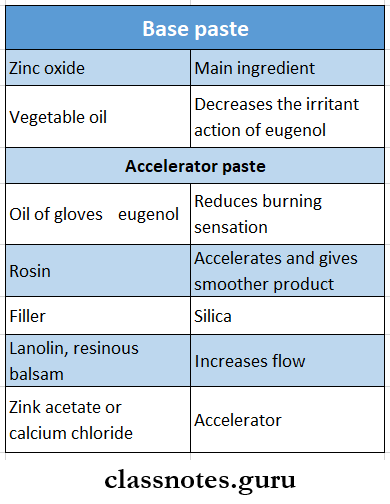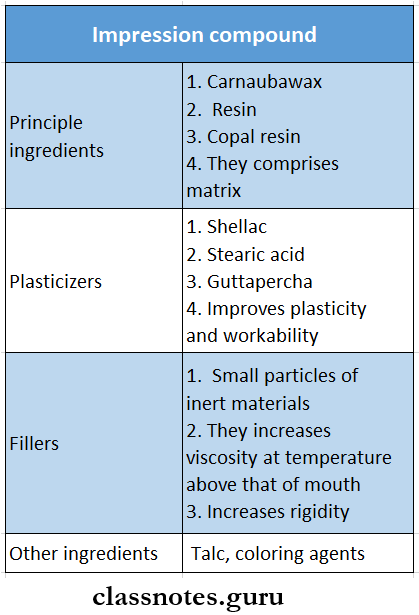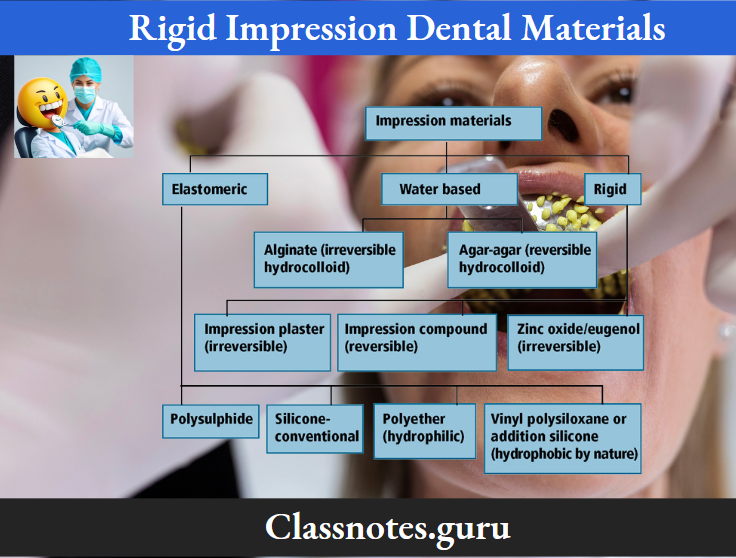Rigid Impression Materials Important Notes
1. Types of ZOE paste
- Type 1 – Hard – sets in 10 minutes
- Type 2 – Soft – sets in 15 minutes
2. Effect of adding water to ZOE paste
- Accelerates setting reaction
- Decreases setting time
3. Composition of ZOE paste

4. Uses of ZOE paste
- Making wash impression of edentulous ridges – most commonly used
- Bite registration
- Post-surgical pack
- Temporary relines
- Root canal filler
- Temporary filling material
- Luting agent
Read And Learn More: Dental Materials Question and Answers
5. Composition of impression compound

Impression Compound In Dentistry
Rigid Impression Materials Long Essays
Question 1. Classify impression materials. Write in detail about the composition, manipulation, and uses of impression compound
Answer:
Impression materials Classification
1. Based on setting mechanisms
- Chemical reaction
- Plaster of Paris
- Zinc oxide eugenol
- Alginate
- Nonaqueous elastomers
- Thermally-induced physical reaction
- Compound wax
- Agar
2. Based on elasticity
- Rigid materials
- Plaster of Paris
- Zinc oxide eugenol
- Compound wax
- Elastic material
- Agar
- Alginate
- Nonaqueous elastomers
Impression Compound:
Impression Compound Composition:

Impression Compound Manipulation:
- Impression compound may be softened over a flame or by immersion in a warm water bath
- It is then removed and usually kneaded with the fingers in order to obtain uniform plasticity
- An oversized tray is selected
- Material is loaded over it and quickly seated onto the tissues to be recorded
- It should be held gently in position until the impression cools below the fusion temperature
- Under no circumstances the impression should be disturbed or removed until it reaches oral temperature
Impression Compound Uses:
- For making a preliminary impression of edentulous ridges
- To make a special tray for the construction of dentures
- For border molding of an acrylic custom tray during the fitting of the tray
- For individual tooth impression
- To check undercuts in inlay preparations

Question 2. Classify impression materials. Write a note on the composition, manipulation, and various uses of zinc oxide eugenol paste
Answer:
Zinc Oxide Eugenol Paste:
Zinc Oxide Eugenol Paste Composition:

Zinc Oxide Eugenol Paste Manipulation:
- Mixing is done on an oil-impervious paper or a glass mixing slab
- The proper proportion of the two pastes is obtained by squeezing two strips of paste of the same length onto the mixing slab
- Two strips of contrasting color are combined with the first stroke of a flexible stainless steel spatula
- Mixing is continued for 1 minute until a uniform color is achieved
- The material is loaded into the tray by swiping on the sides of the tray and then spread in a smooth uniform motion
- It is placed in the mouth till it sets
Zinc Oxide Eugenol Paste Uses:
- As impression material for edentulous ridges
- As surgical dressing
- As bite registration paste
- As temporary filling material
- Root canal filling material
- Cementing medium
- Temporary relining material for dentures
Dental Impression Techniques
Rigid Impression Materials Short Essays
Question 1. Impression compound
Answer:
Impression compound
Impression compound is a rigid impression material
Impression compound Properties:
- Fusion temperature
- The temperature below which a definite reduction in plasticity occurs during the heating of the impression compound is called the fusion temperature
- Impression compound exhibits a fusion temperature range rather than a fixed point
- Thermal properties
- Thermal conductivity
- It has a very low thermal conductivity
- Coefficient of thermal expansion
- It is high due to the presence of resin and wax
- Flow
- Good flow is desirable while impression making
- Dimensional stability
- Relaxation of impression compound occurs in a comparatively short period of time
- To avoid it, the cast is poured immediately
- Detail reproduction
- Due to low flow and high viscosity, it has less detailed reproduction
Question 2. Zinc oxide eugenol impression paste
Answer:
Zinc oxide eugenol impression paste Properties:
- Dimensional stability
- Slight shrinkage occurs during hardening
- Consistency and flow
- The thick paste can compress the tissues
- Zinc oxide eugenol has a very good flow
- Rigidity and strength
- Resist distortion and fracture when removed from the mouth
- Compressive strength -7 Mpa
- Biological properties
- Causes a burning sensation in the mouth
- Can cause tissue irritation
Types Of Rigid Impression Materials
Rigid Impression Materials Short Question And Answers
Question 1. Impression compound
Answer:
Impression compound
Impression compound is a rigid, reversible impression material
Impression compound Classification:
- According to ADA specification no. 3, dental impression compounds are classified into two types as follows:
- Type 1- Impression compound
- Type 2-Tray compound
Impression compound Applications:
- For making a primary impression
- For individual tooth impression
- Peripheral tracing or border molding
- To check undercuts in inlay preparation
Question 2. Zinc oxide eugenol paste
Answer:
Zinc oxide eugenol paste
Zinc oxide eugenol is a rigid impression material
Zinc oxide eugenol paste Advantages:
- It has a sufficient body so as to make up for any minor under-extensions in the tray itself during impression making
- It has enough working time to complete border molding
- Can be checked in the mouth repeatedly
- Registers accurate surface details
- Does not require any separating media since it does not stick to the cast material
- Minor defects can be corrected locally without discarding a good impression
Zinc oxide eugenol paste Disadvantages:
- It requires a special tray for impression making
- It is sticky in nature and adheres to tissues
- Eugenol can cause a burning sensation and tissue irritation
- It cannot be used for making an impression of title and undercut areas as it is inelastic in nature
Rigid Impression Materials In Dentistry
Question 3. Noneugenol paste
Answer:
Noneugenol paste
- Noneugenol pastes were developed to overcome the disadvantages of eugenol like
- Burning sensation
- Disagreeable taste
- Chronic gastric irritation
Noneugenol paste Composition
- Base Paste
- Zinc oxide
- Gum
- Lorothiodol- fungicide
- Reactor
- Coconut fatty acid
- Rosin- a thickening agent
- Chlorothymol- bacteriostatic
- Antibiotics like tetracyclines may be incorporated
- Reaction
- Zinc oxide reacts with carboxylic acid
- This reaction is not affected by temperature and humidity
Zinc Oxide Eugenol Impression Material
Question 4. Mention accelerator for ZOE paste.
Answer:
Mention accelerator for ZOE paste
Accelerators for ZOE paste are
- Calcium chloride
- Zinc acetate
- Primary alcohols
- Glacial acetic acid
